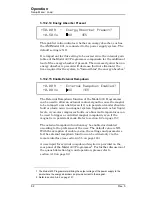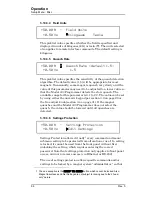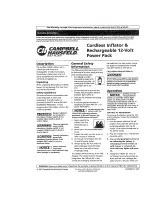
54
Rev. 5
Operation
Setup Menu : Load
reason, small changes in Stability Setting have a large effect on
stability as the Stability Setting value approaches 100%. Changing
the Stability Setting from 99.9% to 99.8% changes the gain
multiplier from 0.1% to 0.2% (changing the gain multiplier by a
factor of 2, a 100% increase in the gain multiplier). Note, however,
that the same 0.1% change in Stability Setting from 90% to 89.9%
only changes the gain multiplier from 10% to 10.1% (changing the
gain multiplier by a factor of 1.01, a 1% change in gain multiplier).
Likewise a 0.1% change in Stability Setting from 50% to 49.9% only
changes the gain multiplier from 50% to 50.1% (changing the gain
multiplier by a factor of only 1.002, a 0.2% increase in the gain
multiplier).
What this means is that if the Stability Setting is being adjusted to
experimentally
determine its optimum setting (using the graph
above as a starting point), no greater than 0.1% changes should be
made above 98%, no greater than 0.2% changes should be made
between 94% and 98%, no greater than 0.5% changes should be
made between 84% and 94%, no greater than 2% changes should be
made between 44% and 84% and no greater than 5% changes
should be made below 44%. See the summary in the table below.
3.10.2.2
Coil Constant
The coil constant is a scaling factor which converts the current to
kilogauss (kG) or tesla (T). It is also often referred to as the
field-to-
current ratio
. The coil constant is specified in kilogauss/ampere or
tesla/ampere. The value can be set by using either the numeric
keypad per section 3.3 on page 29 or the fine adjust knob
(section 3.4 on page 31). If the coil constant value is 0.0 kG/A (or 0.0
T/A), then no conversion from amperes to kilogauss or tesla is
Table 3-4.
Maximum Recommended Stability Setting Changes
Stability Setting Range
Maximum Recommended
Stability Setting Change
98% to 100%
0.1%
94% to 98%
0.2%
84% to 94%
0.5%
44% to 84%
2%
0% to 44%
5%
+0.00 A — Coil Constant (kG/A)
+0.50 Vs
0.90000
Summary of Contents for 05100PS-430-601
Page 2: ......
Page 10: ...x Rev 5 List of Figures ...
Page 12: ...xii Rev 5 List of Tables ...
Page 18: ...xviii Rev 5 Foreword Safety Summary ...
Page 30: ...12 Rev 5 Introduction Operating Characteristics ...
Page 42: ...24 Rev 3 Installation Power Up Procedure ...
Page 114: ...96 Rev 5 Operation Summary of Operational Limits ...
Page 156: ...138 Rev 5 Remote Interface Reference Error Messages ...
Page 168: ...150 Rev 5 Service Return Authorization ...
Page 226: ...208 Rev 5 Index ...
















































